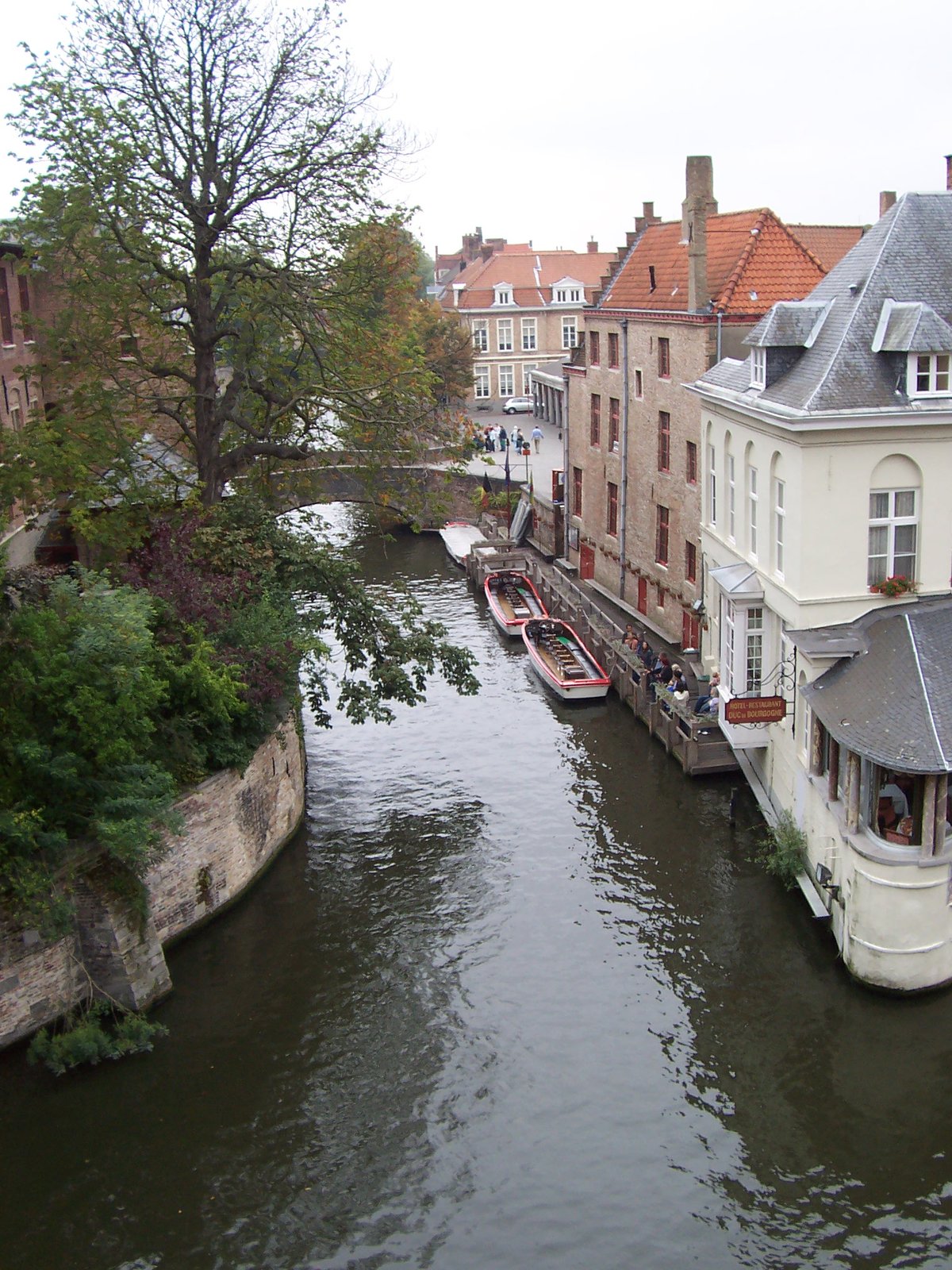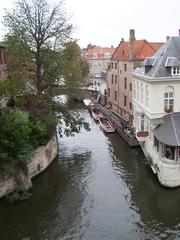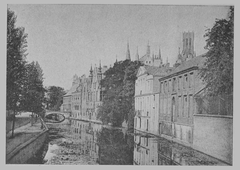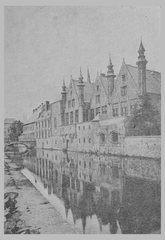
Blinde Ezelbrug Visiting Guide: Bruges, Belgium – Tickets, Hours, and Tips
Date: 14/06/2025
Introduction
Nestled in the heart of Bruges’ UNESCO-listed medieval city center, Blinde Ezelbrug (the “Blind Donkey Bridge”) is one of the city’s most picturesque and storied landmarks. This charming pedestrian bridge, spanning the tranquil Groenerei canal, connects the historic Burg Square to the bustling Fish Market (Vismarkt) via the quaint Blinde-Ezelstraat. Steeped in legend, architectural beauty, and city heritage, Blinde Ezelbrug offers visitors a quintessential Bruges experience—free, accessible, and rich in local color.
This comprehensive guide covers the bridge’s fascinating history, practical visitor information (including hours and accessibility), nearby attractions, and tips for making the most of your visit. Whether you’re a history enthusiast, photographer, or casual explorer, Blinde Ezelbrug is an essential stop on your journey through Bruges.
For further details and resources, refer to the official Visit Bruges website and trusted travel guides like Lonely Planet.
Table of Contents
- Historical Background
- Visitor Information
- Experiencing Blinde Ezelbrug
- Practical Tips & Safety
- Frequently Asked Questions (FAQ)
- Conclusion & Call to Action
- References
Historical Background
Medieval Origins and Evolution
Blinde Ezelbrug stands on a site with roots stretching back to the Middle Ages. The area originally formed a vital link between the comital castle (grafelijke burcht) and Bruges’ commercial heart, facilitating the movement of people and goods between Burg Square and the bustling markets (Inventaris Onroerend Erfgoed). The current bridge, designed by city architect Jean-Brunon Rudd, was completed in 1855 and replaced earlier wooden and stone crossings. Its strategic position at the intersection of key medieval thoroughfares highlights its significance in the city’s development.
Name Origins and Local Legends
The bridge’s evocative name, “Blinde Ezelbrug,” is rooted in local legend. One tale recounts a blind donkey used to power a mill in the area, its eyes covered to prevent dizziness as it circled endlessly (Enchanting Bruges). Historical accounts also reference a nearby inn called “Den Blinden Ezel” (The Blind Donkey), likely giving the bridge and street their names (Visit Bruges). These legends underscore Bruges’ tradition of intertwining folklore with city history.
Architectural Heritage and Conservation
Blinde Ezelbrug’s design follows the classic 19th-century urban bridge style of Flanders, featuring natural stone arches, blue limestone cappings, and cobblestone paving (Inventaris Onroerend Erfgoed). The bridge has been a protected monument since 2002, reflecting Bruges’ commitment to architectural conservation and the preservation of its UNESCO World Heritage status. Its vantage point offers panoramic views of the city’s iconic medieval skyline, including the City Hall, Basilica of the Holy Blood, and the scenic Rozenhoedkaai.
Visitor Information
Visiting Hours and Tickets
Blinde Ezelbrug is a public pedestrian bridge that is open 24/7, year-round. There are no tickets or entry fees required, making it a hassle-free and budget-friendly highlight of any Bruges visit (Visit Bruges).
Accessibility
- Pedestrian-Only: The bridge and connecting streets are car-free and ideal for walking.
- Mobility: Surfaces are cobblestoned and can be uneven, which may present challenges for wheelchair users or those with limited mobility. There are no dedicated ramps or lifts; nearby alternative routes may offer easier access (Visit Bruges).
- Strollers/Bikes: Strollers are manageable with care, though the bridge can be crowded during peak times. Bicycles are permitted but should be walked across.
Getting There and Travel Tips
- On Foot: Located in the city center, Blinde Ezelbrug is easily reached from all major attractions.
- Public Transport: The nearest bus stop is Brugge Dijver. The main train station (Station Brugge) is about a 20-minute walk or a short bus ride away.
- Parking: The closest facility is Parking Pandreitje, about a 5–10 minute walk to the bridge.
Special Events and Tours
Blinde Ezelbrug is frequently featured in guided walking tours of Bruges, which delve into the city’s history and local legends (Touropia). During festivals, such as the Winter Glow light trail or the Procession of the Holy Blood in May, the bridge area is beautifully illuminated and included in event routes (Rick Steves).
Experiencing Blinde Ezelbrug
Best Times to Visit
- Early Mornings & Evenings: For tranquil experiences, soft natural light, and fewer crowds, visit at sunrise or after 6–7 PM, particularly outside high season (July–August).
- Off-Season: November–March offers a quieter atmosphere and magical winter scenes (SoloSophie).
Photography Tips
- Scenic Views: From the bridge, capture iconic shots of the Groenerei canal, medieval facades, and flower-adorned balconies (Velvet Escape).
- Lighting: Sunrise and golden hour provide the best conditions for dramatic photos. Tripods are allowed, but be considerate of other visitors.
- Nearby Spots: Don’t miss Rosary Quay (Rozenhoedkaai), a top photo destination just steps away.
Nearby Attractions
- Burg Square: Gothic City Hall and Basilica of the Holy Blood.
- Vismarkt (Fish Market): Morning market with local seafood and crafts.
- Huidenvettersplein: Quaint square with cafés and shops.
- Jan van Eyckplein: Scenic square named after the Flemish master painter.
- Groeningemuseum: Leading collection of Flemish and Belgian art.
Facilities and Amenities
- Restrooms: Available at nearby cafés, the Fish Market, and tourist offices (small fee may apply).
- Food & Drink: Sample Belgian waffles, chocolate, and beer at nearby eateries. For more authentic and affordable options, venture a few streets away (The Crazy Tourist).
- Shopping: Blinde Ezelstraat features boutiques and lace shops; for authentic Bruges lace, visit the Lace Centre or reputable stores.
Practical Tips & Safety
- Footwear: Wear comfortable shoes due to cobblestone surfaces.
- Weather: Bruges’ climate is mild but often rainy—pack an umbrella or raincoat (Touropia).
- Safety: The area is generally safe, but be vigilant for pickpockets in crowds.
- Etiquette: Respect the bridge as a protected monument—no climbing or defacing, and keep noise levels low, especially in the early morning or evening.
- Language: Dutch (Flemish) is official, but English is widely understood.
Frequently Asked Questions (FAQ)
Q: Are tickets required to visit Blinde Ezelbrug?
A: No, visiting the bridge is free and open to the public.
Q: What are the visiting hours for Blinde Ezelbrug?
A: The bridge is accessible 24/7, year-round.
Q: Is Blinde Ezelbrug wheelchair accessible?
A: Accessibility is limited due to cobblestones and lack of ramps. Contact the tourist office for assistance.
Q: Can I take photos on the bridge?
A: Yes, photography is encouraged. Be considerate of other visitors, especially during busy periods.
Q: Are guided tours available that include Blinde Ezelbrug?
A: Many walking and canal tours feature the bridge as a highlight.
Q: Where can I park near Blinde Ezelbrug?
A: Parking Pandreitje is the nearest car park, about a 5–10 minute walk away.
Conclusion & Call to Action
Blinde Ezelbrug is far more than a simple crossing; it is a living symbol of Bruges’ layered history, architectural finesse, and storytelling tradition. With free, round-the-clock access and proximity to many major sights, it is a must-see for anyone exploring this enchanting city.
Plan your visit for the early morning or evening to experience the bridge’s serene beauty. Explore nearby markets, squares, and museums for a complete Bruges itinerary. For immersive narratives and expert tips, download the Audiala app, and follow us on social media for the latest updates.
Make your Bruges journey unforgettable—let Blinde Ezelbrug be the gateway to your adventure in this medieval marvel!
References and Further Reading
- This is a sample text. (Visit Bruges)
- This is a sample text. (Enchanting Bruges)
- This is a sample text. (Velvet Escape)
- This is a sample text. (Touropia)
- This is a sample text. (Inventaris Onroerend Erfgoed)
- This is a sample text. (Lonely Planet)
- This is a sample text. (The Crazy Tourist)
- This is a sample text. (Rick Steves)
- This is a sample text. (SoloSophie)













































































